Humanity's Most Urgent Challenge
Evening sun in the Andes, Chile | photography ©Yuri Beletsky
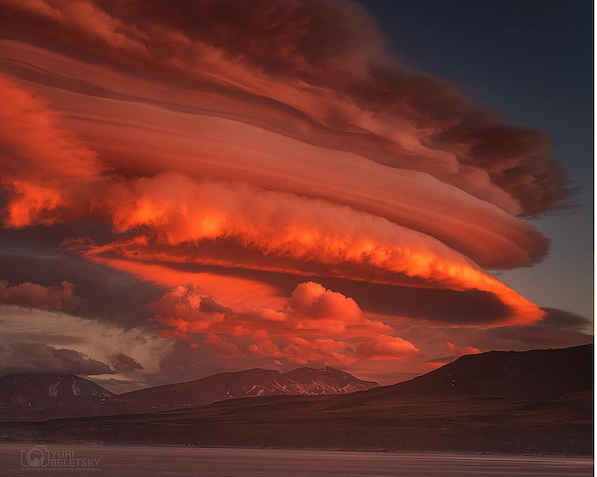 For at least 50,000 years, humanity has been on a journey of separation—pulling back from nature and becoming ever more differentiated, individuated, and empowered. In recent decades, we have become so dominant as a species that we are producing Earth-changing trends—global warming, species extinction, unsustainable population, massive famines, waves of migration, and more—that threaten humanity’s future. Now, with stunning abruptness, humanity is being challenged to turn from the familiar path of progressive separation to an unfamiliar path of global caring and cooperation. The transition from self-serving separation to world-serving cooperation confronts us with an evolutionary crisis: Who are we? What kind of Universe do we live in? Where are we going?
For at least 50,000 years, humanity has been on a journey of separation—pulling back from nature and becoming ever more differentiated, individuated, and empowered. In recent decades, we have become so dominant as a species that we are producing Earth-changing trends—global warming, species extinction, unsustainable population, massive famines, waves of migration, and more—that threaten humanity’s future. Now, with stunning abruptness, humanity is being challenged to turn from the familiar path of progressive separation to an unfamiliar path of global caring and cooperation. The transition from self-serving separation to world-serving cooperation confronts us with an evolutionary crisis: Who are we? What kind of Universe do we live in? Where are we going?
Because we are confronting the limits of the Earth’s ecosystem to carry the burden of humanity, we are also confronting our assumptions about the nature of the Universe and our evolutionary journey. Do we continue our rapid march into materialism, grounded in the assumption that we live in a Universe that is indifferent to humanity and comprised mostly of dead matter and empty space? Or do we open to a transforming insight from the combined wisdom of science and the world’s spiritual traditions: The Universe is not dead at its foundations but is profoundly alive and we humans are an integral part of that larger aliveness? In the words of Plato, “The Universe is a single living creature that contains all living creatures within it.” Life within life within life.
Our view of the Universe profoundly impacts how we live in the world. If we think we live in a Universe that is comprised of non-living particles without meaning and purpose, then it makes sense to exploit that which is dead on behalf of ourselves, the most visibly alive. Alternatively, if we have direct experiences of connecting with the aliveness in nature and the world around us, then it is natural to respect and care for the countless expressions of aliveness. These are two radically different ways of looking at the Universe and, in turn, produce dramatically different views of our identity and evolutionary journey. This leads to a startling conclusion: The most urgent challenge facing humanity is not climate change, or species extinction, or unsustainable population growth; rather, it is how we understand the Universe and our intimate relationship within it. Our deepest choices for the future emerge from this core understanding.
At the Evolutionary Crossroads
How have we come to such a critical crossroads in our evolutionary journey? First, in the last several hundred years, we have been spectacularly successful in exploiting the abundance of the Earth’s resources to create a short period of unprecedented material prosperity for a minority of the Earth’s population. This burst of affluence emerged from a worldview described as ‘scientific materialism,’ which regards the Universe as unaware of and indifferent to human existence in the unthinking and unfeeling dance of dead particles in a cosmic system without purpose or meaning. Second, based on this worldview, we have been consuming the Earth’s resources far beyond her rates of regeneration. Short-term material prosperity is being gained at the cost of long-term ecological ruin. As Wendell Berry reminds us, nature “has more votes, a longer memory, and a sterner sense of justice than we do.” We are creating by our own hand a long-term future that is unforgivingly inhospitable for advancing human civilization.
We are now being compelled by circumstances to come together—collectively and rapidly—to cope with profound climate disruption, massive human migrations, unsustainable population growth, critical shortages of key resources such as water, the threatened extinction of nearly half of all animal and plant species, and much more. As world-changing trends of enormous magnitude converge and amplify one another, the people of Earth will confront the unyielding reality that, unless we wake up and work together, we have only the legacy of a grievously wounded Earth and impoverished future to leave to our children and grandchildren. We require a new pathway ahead and are reminded of Einstein’s famous words that “we cannot solve our problems with the same thinking we used to create them.”
We are moving through a perilous phase of planetary transition. Will we have the species-wisdom to make deep, structural changes in our manner of living and turn toward a more sustainable future? If not, the alternatives are the collapse and even extinction of human civilizations. It is unwise to be complacent about the possibility of collapse as this has happened numerous times throughout history. More than 20 major civilizations have collapsed over the millennia, including the empires of the Romans, Mayans, Aztecs, Easter Islanders, Anasazi, Mesopotamians, and the Soviets. Importantly, many examples of collapse involve climate change as a key, contributing factor.
Although collapse has occurred numerous times in the past, today is different in one crucial respect: There are no frontiers left. The circle has closed. The entire world has become a single, integrated system—economically, ecologically, and socially. Never before has the entire planet been at risk of collapse and taking all the world’s civilizations down at the same time. Humanity has never before experienced the collapse of an embryonic but truly global civilization such as exists today. Our time of planetary transition is truly a great transition, unprecedented in human history and deeply formative in shaping the long-range future.
To move swiftly through this perilous time of planetary transition requires unprecedented breakthroughs in how we live and relate to one another. Yet, cooperation will be difficult in a world that is unraveling and where most people are coping with chronic, planetary-scale, traumatic stresses. A natural tendency is for people to separate and seek islands of safety to ride out the disruptive storms of transition that are beginning to blow through the world. However, if we pull apart and seek our personal security by retreating from the world and isolating ourselves, then systemic problems are certain to escalate and produce the very future of ruinous collapse we most fear.
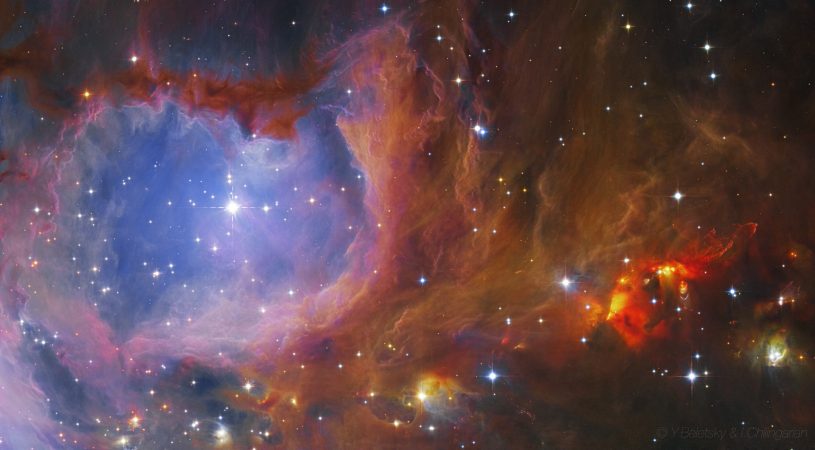
Great Nebula of Orion, birthplace of thousands of stars | photography ©Yuri Beletsky
The Remarkable Invitation
Being unflinchingly realistic, it does not seem likely we will turn away from our current path of separation—with its growing inequities, over-consumption of resources, and deep injury to the Earth—unless we discover a pathway into the future that is so truly remarkable, transformative, and welcoming that we are drawn together by the magnitude and promise of its invitation. Just in time, that pathway is being revealed by insights converging from science and the world’s wisdom traditions. We are discovering that, instead of struggling for meaning and a miracle of survival in a dead Universe, we are being invited to learn and grow forever in the deep ecologies of a living Universe. To step into the invitation of learning to live in a living Universe represents a journey so extraordinary that it invites us to transcend the wounds of history and begin a process of healing and reconciliation to realize a remarkable future we can only attain together.
The Nature of Our Cosmic Home
In contemplating a great turn toward this new pathway of evolution, it is important to ask: Is the Universe truly as Plato described—‘a single living creature’ that contains all living creatures within it? Seeing the Universe as a super-organism with a permeating aliveness is not new—this was humanity’s basic understanding for tens of thousands of years until gradually replaced by the worldview of scientific materialism roughly 300 years ago. Since then, the scientific community has been employing its ever more powerful tools to explore the nature of reality and has discovered a Universe of astonishing depth and subtlety. In turn, the ancient intuition of a living Universe is now being reconsidered freshly as science cuts away superstition to reveal the cosmos as a place of unexpected wonder, depth, and sophistication. Here are six key attributes emerging from science and cosmology that point toward a living Universe:
A Unified Whole: In the last several decades, scientific experiments have repeatedly confirmed ‘non-locality’ and the discovery that the Universe is a deeply unified system at the quantum level that communicates with itself instantly, across impossibly vast distances. To illustrate, at the speed of light, it takes more than eight minutes for a photon to travel from the sun to the Earth and more than 14 billion years to travel across our visible Universe. Yet, quantum physics demonstrates these unimaginably vast distances are traversed and transcended, instantaneously, in the quantum realm. Science no longer views the Universe as a disconnected collection of planets, stars, and fragments of matter. Instead, the Universe is fully unified and connected with itself at every moment. In the words of the physicist David Bohm, the Universe is ‘an undivided wholeness in flowing movement.’
Empty Space is Not Empty: For centuries, scientists thought empty space was ‘empty.’ Recently, scientists have discovered that an extraordinary amount of background energy permeates the Universe! This invisible energy accounts for an estimated 96 percent of the known Universe. In turn, the entire visible Universe—atoms, people, planets, stars, and galaxies— constitutes only 4 percent of the total Universe. Two kinds of invisible energy are known to exist: dark matter (a contractive force) accounts for roughly 23 percent of the invisible Universe, and dark energy (an expansive force) accounts for approximately 73 percent of the Universe. We are immersed within a vast sea of largely invisible, subtle, but astonishingly powerful energies, with an array of capacities we are only beginning to discover and understand.
A Co-Arising Universe: At every moment, the entire Universe is emerging freshly as a singular orchestration of cosmic expression. There is one grand symphony in which we are all players, a single creative expression emerging freshly at each moment—a Uni-verse. While an evolving Universe provides a stunning narrative of ‘horizontal’ unfolding across time, the insight of an emerging Universe adds the ‘vertical’ dimension of the Universe continuously arising in time. Despite outward appearances of solidity and stability, the Universe is a completely dynamic system. Nothing endures. All is flow. In the words of the cosmologist Brian Swimme, “The Universe emerges out of an all-nourishing abyss not only fourteen billion years ago but in every moment.”2
Consciousness at Every Scale: Scientists are finding evidence for consciousness or a knowing capacity throughout the Universe. From the atomic level to the galactic scale, a self- organizing, centering capacity is at work that is fitting for each scale. In turn, the capacity for centering self-organization points to the presence of some level of knowing consciousness. The physicist and cosmologist Freeman Dyson writes that, at the atomic level, “It appears that mind, as manifested by the capacity to make choices, is to some extent inherent in every electron.”3 This does not mean that an atom has the same consciousness as a human being, but rather that an atom has a reflective capacity appropriate to its form and function. Max Planck, developer of quantum theory, stated, “I regard consciousness as fundamental. I regard matter as derivative from consciousness. We cannot get behind consciousness. Everything that we talk about, everything that we regard as existing, postulates consciousness.”4 An ecology of consciousness permeates the Universe.
Freedom at the Foundations: Quantum physics describes reality in terms of probabilities, not certainties. This means that uncertainty and freedom are built into the very foundations of existence. No individual part of the cosmos determines the functioning of the whole; rather, everything is interconnected with everything else, weaving the cosmos into one vast interacting system. In turn, it is the consistency of interrelations of all the parts that determines the condition of the continuously emerging whole. We therefore have great freedom to act within the limits established by the larger web of life.
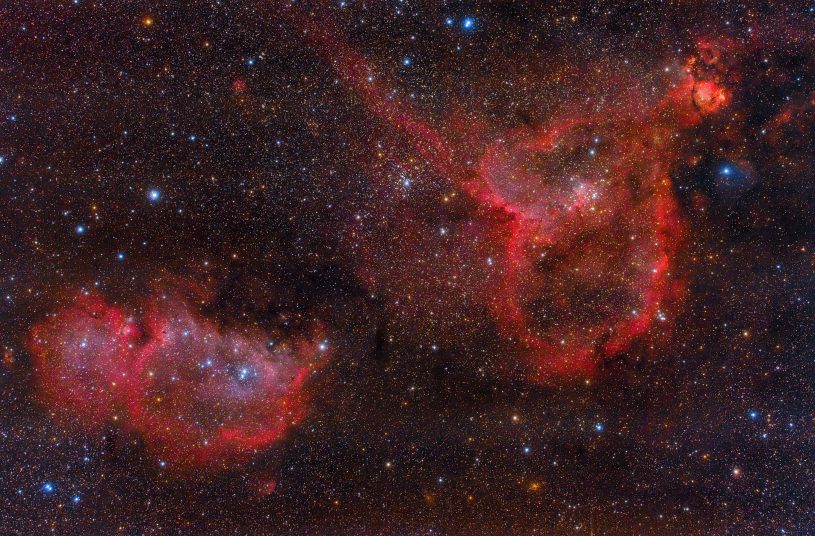
heart and soul nebula | photography ©Leonardo Orazi
Able to Reproduce Itself: A vital capacity for any living system is the ability to reproduce itself. A widespread view in cosmology is that our Universe may reproduce itself through the functioning of black holes, which represents the seeds from which a new Universe can blossom and grow. Physicist John Gribbin writes, “Instead of a black hole representing a one-way journey to nowhere, many researchers now believe that it is a one-way journey to somewhere—to a new expanding Universe in its own set of dimensions.”5 Given the presence of billions of black holes in our Universe, there could be countless other cosmic systems continuously being born by ‘budding off’ from our Universe through the birth canal of black holes. Gribbin writes that Universes are not only alive; they also evolve as do other living systems: “Universes that are ‘successful’ are the ones that leave the most offspring.”6 The idea that there have been countless Universes evolving through time is not new. A precursor can be found from 1779 when David Hume wrote, “Many worlds might have been botched and bungled, throughout an eternity, ere this system was struck out; much labour lost, many fruitless trials made; and a slow, but continued improvement carried on during infinite ages in the art of world-making.”7When we bring these attributes together, a clearer picture of our remarkable Universe comes into focus. As a provisional paradigm, the most meaningful description of our Universe seems to be that of a living, cosmic hologram—a unified super-organism that is continuously regenerated at each moment and whose essential nature includes consciousness, or a knowing capacity, that enables systems at every scale of existence to center themselves and exercise some measure of freedom of choice. In addition, the Universe appears able to reproduce itself via black holes within a vastly larger cosmic garden or multi-verse where our Universe is but one among countless others. Overall, the vision of our Universe emerging from science is that of a magnificent super-organism evolving in complexity and consciousness. We are completely immersed within this regenerative, holographic universe.
How the Wisdom Traditions Regard the Universe
How does the emerging, scientific view of a living Universe fit with the originating insights of the world’s major wisdom traditions? Is there a place of meeting in their respective views? Despite their many differences, when we penetrate the depths of the world’s major spiritual traditions, a stunning understanding about the Universe emerges that is in accord with insights from the frontiers of science: We live within a living Universe that arises, moment by moment, as an undivided whole in an unutterably vast process of awesome precision and power. The following quotes illustrate how this remarkable understanding is expressed across the world’s major religions (excerpted from my book, The Living Universe):
Christian: “God is creating the entire Universe, fully and totally, in this present now. Everything God created… God creates now all at once.” ~ Meister Eckhart, Christian mystic
Islam: “You have a death and a return in every moment… Every moment the world is renewed but we, in seeing its continuity of appearance, are unaware of its being renewed.”9 ~ Rumi, 13th century Sufi teacher and poet
Buddhist: “My solemn proclamation is that a new Universe is created every moment.”10 ~ D.T. Suzuki, Zen teacher and scholar
Hindu: “The entire Universe contributes incessantly to your existence. Hence the entire Universe is your body.”11 ~ Sri Nisargadatta, Hindu teacher
Taoist: “The Tao is the sustaining Life-force and the mother of all things; from it, all things rise and fall without cease.”12 ~ Tao Te Ching
Indigenous: “… there was no such thing as emptiness in the world. Even in the sky there were no vacant places. Everywhere there was life, visible and invisible”13 ~ Luther Standing Bear, Lakota elder
Beneath the differences in language, a common vision is being described. The Universe is continuously emerging as a fresh creation at every moment. All point to this same, extraordinary insight. The Universe is not static, nor is its continuation assured. Instead, the Universe is like a cosmic hologram that is being continuously upheld and renewed at every instant.14 A universal encouragement found across the world’s wisdom traditions is to live in the ‘NOW.’ This core insight has a clear basis in physics: The present moment is the place of direct connection with the entire Universe as it arises continuously. Each moment is a fresh formation of the Universe, emerging seamlessly and flawlessly. When we are in the present moment, we are literally riding the wave of continuous creation of the cosmos—reality surfing.
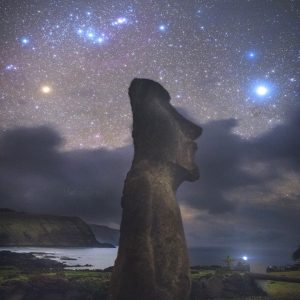
Orion over Moai statue on Easter Island. I took it last year when the weather on the island had been really bad for weeks. In a rare window between the clouds I managed to capture the scene. The Moai looks a bit out of focus—it’s done on purpose. I wanted to focus on the sky, to add a bit of perspective. ~ Yuri Beletsky
A Living Universe in Everyday Human Experience
How does a living Universe perspective fit with our everyday human experience? If the unity of existence is not an experience to be created but an always-manifesting condition waiting to be appreciated, then how widespread is this experience in people’s lives? Do many people experience the everyday world around ourselves as ‘alive?’ Scientific surveys give us insight into this key question:
A global survey involving 7,000 youths in 17 countries was taken in 2008. It found that 75 percent believe in a ‘higher power,’ and a majority say they have had a transcendent experience, believe in life after death, and think it is ‘probably true’ that all living things are connected.15 These views are in accord with a paradigm of aliveness.
We can secure further insight from scientific surveys conducted in the United States that show a measurable transformation in mainstream consciousness is underway.
In 1962, a survey of the adult population in the US found that 22 percent reported having a profound experience of communion with the Universe. By 2009, the percentage of the population reporting a ‘mystical experience’ had grown dramatically to 49 percent of the adult population.16
In a national survey of the US in 2014, nearly 60 percent of adults reported they regularly feel a deep sense of ‘spiritual peace and wellbeing,’ and 46 percent say they experience a deep sense of ‘wonder about the Universe’ at least once a week.17
A 2002, national Gallup survey asked respondents to rate the statement “I have had a profound religious experience or awakening that changed the direction of my life.” A stunning 41 percent of Americans (about 80 million adults at the time) said the statement completely applies to them.18
These surveys show that experiences of profound communion with the aliveness of the Universe are not a fringe phenomenon but, instead, are familiar encounters for a large portion of the public. Humanity is measurably waking up to a bio-cosmic view of ourselves within the Universe.
Awakening to an intimate connection with the unity and intelligent aliveness of the Universe is often accompanied by feelings of great joy, boundless love, and the presence of a subtle, radiant light. To illustrate, below is a classic account of a spontaneous awakening experience. While an undergraduate student, F.C. Happold had this experience of communion with the permeating aliveness of the Universe:
There was just the room, with its shabby furniture and the fire burning in the grate and the red-shaded lamp on the table. But the room was filled by a Presence, which in a strange way was both about me and within me, like light or warmth. I was overwhelmingly possessed by Someone who was not myself, and yet I felt I was more myself than I had ever been before. I was filled with an intense happiness, and almost unbearable joy, such as I had never known before and have never known since. And over all was a deep sense of peace and security and certainty.19
Turning from spontaneous awakening to the intentional exploration of consciousness, for more than two thousand years, pioneering individuals have been investing their lives in solitude and sustained meditation to investigate directly the nature of reality. What these explorers of consciousness have discovered is not a grey, machine-like hum of a non-living Universe but, instead, an ocean of unbounded love, light, and creative intelligence whose nature is beyond the reach of words.20 When our personal aliveness becomes transparent to the aliveness of the living Universe, awakening experiences of wonder and awe emerge naturally. As we open into the cosmic dimensions of our being, we feel more at home, less self-absorbed, more empathy for others, and an increased desire to be of service to life. These shifts in perspective are immensely valuable for building a sustainable future.
Humanity’s awakening is being further accelerated by virtual reality technologies that immerse people in alternative worlds of experience and expand how we think about the ‘ordinary world’ around us. Inexpensive headsets with a computer interface are making immersive experiences in alternative realities widely available for education, medicine, games, urban planning, and much more. In a simulation, nothing real ‘really’ exists—except as a computer program and yet, when we put on a VR headset, within seconds our sensory experiences feel incredibly real. What is ‘reality?’ By directly experiencing our immersion within an alternative reality that feels real to our senses, our curiosity can be awakened regarding the reality of our everyday experience. Virtual reality technologies are an evolutionary catalyst,awakening mainstream cultures to viewing the Universe as a continuously refreshed, cosmic hologram that can be known consciously and directly because we are an integral expression of it.
As these diverse streams of awakening converge, they are forming a river of wisdom that is transforming global consciousness and culture.
Our Bio-Cosmic Identity and Evolutionary Journey
Halo around full moon | photography ©Yuri Beletsky
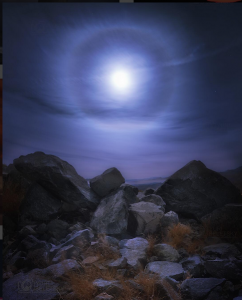 Powerful trends are converging to awaken the paradigm of a living Universe in mainstream global culture: astonishing new attributes of the Universe from scientific discoveries, confirming insights from the world’s wisdom traditions, measurable growth in awakening experiences from around the world, accelerated learning through virtual reality technologies, and much more.
Powerful trends are converging to awaken the paradigm of a living Universe in mainstream global culture: astonishing new attributes of the Universe from scientific discoveries, confirming insights from the world’s wisdom traditions, measurable growth in awakening experiences from around the world, accelerated learning through virtual reality technologies, and much more.
What does this combined wisdom tell us about our identity and evolutionary journey?
Bio-Cosmic Identity: From a living Universe perspective, our identity is immeasurably larger than our biological selves. Recall from cosmology that 96 percent of the known universe is comprised of invisible energy. We are an inseparable part of the known universe, which means that 96 percent of who we are consists of invisible energy. The 4 percent of who we are is manifest in our physical biology and the remaining 96 percent is manifest as invisible energies. We are vastly more than a skin-encapsulated being. Our biological existence is inseparable from the larger aliveness of the living Universe. Seeing ourselves as part of the fabric of creation awakens our sense of connection with, and compassion for, the totality of life. Cosmologist Brian Swimme explains that the intimate sense of self-awareness we experience bubbling up at each moment “is rooted in the originating activity of the Universe. We are all of us arising together at the center of the cosmos.” We once thought that we were no bigger than our physical bodies, but now we are discovering that we are deeply connected participants in the continuous co-arising of the entire Universe. Awakening to our larger identity as both unique and inseparably connected with a co- arising Universe transforms feelings of existential separation into experiences of subtle communion as bio-cosmic beings. We are far richer, deeper, more complex, and more alive than we ever thought. To discover this in our direct experience is to enter a new age of exploration and discovery.
Cosmic Purpose: To be born as a human being is a rare and precious gift. Our bodies are biodegradable vehicles for acquiring soul-growing experiences. As compostable conduits for channeling learning experiences, our bodies are the current expressions of a creative aliveness that, after nearly 14 billion years, enables the Universe to look back and reflect upon itself. While we have the gift of a body to anchor our experience, it is important to recognize our bio-cosmic nature. In the Gospel of Thomas, Jesus says, “Take heed of the Living One while you’re alive, lest you die and seek to see Him and be unable to do so.” An ancient Greek saying speaks even more directly, “Light your candle before night overtakes you.” If the Universe were non-living at its foundations, it would take a miracle to save us from extinction at the time of death, and then to take us from here to a heaven (or promised land) of continuing aliveness. However, if the Universe is alive, then we are already nested and growing within its aliveness. When our physical body dies, the life-stream that we are makes its passage to a fitting home in the larger ecology of aliveness. We don’t need a miracle to save us—we are already inside the miracle of sustaining aliveness. Instead of being saved from death, our job is to bring mindful attention to our ever-emerging aliveness in the here and now.We are shifting from seeing ourselves as accidental creations wandering through a lifeless cosmos without meaning or purpose to seeing ourselves engaged in a sacred journey of discovery in a Universe with stunning depth and richness of purpose. An old saying goes, “A dead man tells no stories.” In a similar way, “A dead Universe tells no stories.” In contrast, a living Universe is itself a vast story continuously unfolding with countless characters playing out gripping dramas of awakening, inseparable from the artistry of world-making. The Universe is a living, unfolding creation. Saint Teresa of Avila saw this when she wrote, “The feeling remains that God is on the journey, too.” If we see ourselves as participants in a cosmic garden of life that has been growing patiently over billions of years, then we feel invited to shift from feelings of indifference, fear, and separation to feelings of curiosity, love, and participation. In the words of Annemarie Schimmel, “Once the journey to God is finished, the infinite journey in God begins.”
Milky Way from Andes road | photography ©Yuri Beletsky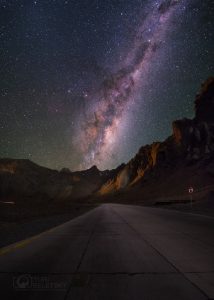
Natural Ethics: If we are no more than biological entities, then it makes sense to think we could disconnect ourselves from the suffering of the rest of life. However, if we are all swimming in the same ocean of subtle aliveness, then it is understandable that we each have some measure of direct experience of being in communion with the larger fabric of life. Because we share the same matrix of existence, the totality of life is already touching each of us and co-creating the field of aliveness within which we exist. A felt ethics emerges from our intuitive connection with the living Universe in the form of a ‘moral tuning fork.’ We can each tune into the non-local field of life and sense what is in harmony with the wellbeing of the whole. When we are in alignment, we experience a warm, positive hum of wellbeing as a kinesthetic sense that we may call ‘compassion.’ In a similar way, we can also experience the dissonant hum of discordance and dissatisfaction. In recognizing we can contribute with discernment to the unfolding story of cosmic evolution, we shift from a sense of existential disconnection to feelings of intimate communion with and regard for all that exists.
Sustainable Living: If a top priority is growing our experience of aliveness, then it is only natural for us to choose ways of living that afford greater time and opportunity to develop the areas of our lives where we feel most alive—investing our time in nature, nurturing relationships, caring communities, creative expressions, and service to others. In seeing the Universe as alive, we naturally shift our priorities from an ‘ego economy’ based upon consuming deadness to a ‘living economy’ based upon growing aliveness. An aliveness economy seeks to touch life more lightly while generating an abundance of meaning and satisfaction. Aliveness is the only true wealth.
Eco-Villages and New Communities: In turbulent times, it is natural to look for the familiarity and safety of ‘home.’ But what does ‘home’ mean in our time of profound, global change? Is home a familiar dwelling? Or is home a visceral and intuitive feeling that we have deep inside? For many, home is a feeling of safety, acceptance just as you are, and a sense of belonging. We also have the feeling of being home when we are deeply relaxed within ourselves and making meaningful contributions to the wellbeing of those around us. With this as a guide, we can anticipate that, as the old world breaks down economically, socially, and environmentally, new searches for ‘home’ are underway—and this is leading many to search for new kinds of community.As the world unravels, smaller communities can provide lifeboats of resilience and belonging to weather the storms of transition. Communities of the scale of a ‘village’ (roughly one or two hundred people) are small enough to support a rich array of personal relationships and large enough to support a vibrant micro-economy and diverse social activities. Large-scale breakdowns will produce local breakthroughs in patterns of living. Cities can be decentralized rapidly into thousands of relatively self-reliant and highly resilient ‘eco-villages,’ each with distinctive adaptations of architecture, culture, and expressions of sustainability. Common to most would be a child-care facility and play area, a common house of some kind (for community meetings, celebrations, and regular meals together), a community garden, a recycling and composting area, solar energy systems, a bit of open space, and a workshop. Each could offer a variety of services to the surrounding eco-villages as well—for example, organic gardening, green building, conflict resolution, health care, home schooling, elder care, and so on. Ecovillages could replace the alienating and insecure landscape of massive urban regions with countless, small islands of sanity, security, and resilient community. The culture and consciousness of each village could be unique while the orienting context of living lightly in a living universe could be shared by a majority.
Mercury over the Andes | photography ©Yuri Beletsky
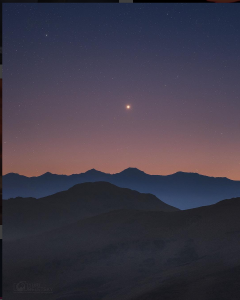
Awakening to our conscious connection with the living Universe naturally expands our scope of concern and compassion—and brightens the prospect of working together to build a sustainable future. However, making the turn from separation to connection does not end our journey of learning. As we discover the astonishing depths and subtlety of the Universe, we recognize we have as much to learn on our journey of return as we have on our long journey of separation. This is humbling news. Instead of the current era representing the pinnacle of human evolution, we appear to be approaching a mid-way point in the journey of awakening as we turn from separation toward community and cooperation. We still have far to go and much to learn to reach our initial maturity as a dynamically stable, species-civilization.
Humanity’s Choice
Our first task as a human community is to recognize the remarkable choice directly before us. On the one hand, if we regard the universe as dead at its foundations, then feelings of existential alienation, anxiety, dread, and fear are understandable. Why seek communion with the cold indifference of lifeless matter and empty space? If we relax into a dead Universe, we will simply sink into existential despair, so better to live on the surface of life. On the other hand, if we live in a living Universe, then feelings of subtle connection, curiosity, and gratitude are natural. When we see ourselves as participants in a cosmic garden of life that has been developing patiently over billions of years, our regard for the universe shifts from indifference, fear, and cynicism to curiosity, love, and awe. Humanity’s future pivots on which understanding prevails and the choices that naturally follow.
A young evolving star in the Milky Way | photography | NASA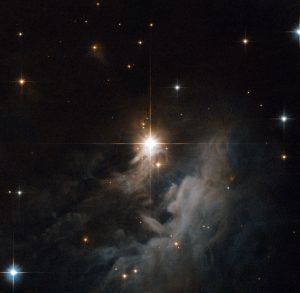
The wellbeing of humanity and the Earth depends upon this generation waking up, growing up, and moving from our adolescence into our early adulthood as a species, and thereby establishing a new relationship with nature, other humans, and the living Universe. If we do not welcome the miracle of life around us and within us, the alternative seems likely to be our effective extinction as a species. Climate chaos, sea level rise, mass migrations, species extinction and more are accelerating and moving past critical tipping points, producing irreversible changes to the Earth, and making humanity’s turn toward a sustainable future immensely more difficult. Would we choose ruin over life? As unthinkable as it may be, it seems painfully realistic to conclude that unless the great diversity of humanity can find an awe-inspiring bridge to a compelling future that is grounded in a commonly felt experience of tremendous, untapped evolutionary potential, we will not have the soulful motivation needed to turn from separation and survival to community and co-evolution.
Our situation is unprecedented: We are being pushed by Earth-sized ecological necessity and pulled by Universe-sized evolutionary opportunity. If we lose sight of where we are (living within a living Universe), we profoundly diminish our understanding of who we are (beings of both biological and cosmic dimensions) and the journey we are on (learning to live within the depths of cosmic aliveness). Ultimately, in learning to live in a living Universe, we are learning to live in the deep ecology of existence—in eternity. This is such an astonishing call to our soulful nature from the deep compassion of a living Universe that we would be spiritual fools to ignore an invitation whose value is beyond price or measure.
We are in an early ‘establishing phase’ of conscious evolution where we are just beginning to recognize ourselves in the mirror of reflective consciousness. Although the Universe has been growing us through countless lifetimes, only now are we waking up to who and what we truly are. As we use the Internet and social media to collectively witness our planetary journey, it is helpful to view the path as a reflexive loop that turns back upon itself. We are in the process of realizing our self-given name as a species: homo sapiens sapiens or the being that ‘knows that it knows.’ In becoming ‘doubly wise,’ we turn the knowing faculty back upon itself and, ultimately, become aware that we are awareness itself—an invisible knowing-presence at the foundations of the living Universe.
As the push of outer necessity meets the pull of untapped inner capacity, humanity is beginning to awaken. And yet, adversity trends such as radical climate change are accelerating so rapidly there is a real danger that humanity’s responses could prove to be too little and too late—and we may veer off into a new dark age. If we are distracted and in denial, and overlook the urgency and importance of the great transition now underway, we will miss a unique, never-to-be-repeated, evolutionary opportunity. Each generation is asked to make sacrifices for the next, to be a caretaker for the future. This generation is being pushed by an injured Earth and pulled by a welcoming Universe to make a monumental gift to humanity’s future: working together with equanimity and maturity to consciously realize our bio-cosmic potential and purpose of learning to live in a living Universe.
Endnotes
1 This essay was developed for the “Global Purpose Movement” (https://globalpurposemovement.com) and was adapted from my forthcoming book, Humanity’s Journey Home: Learning to Live in a Living Universe.
2 Swimme, B. (1996). The hidden heart of the cosmos (p.100). New York: Orbis Books.
3 Dyson, F. (1988). Infinite in all directions (p. 297). New York: Harper & Row.
4 Planck, M. (1931). The Observer.
5 Gribbin, J. (1993). In the beginning: The birth of the living universe (p. 244). New York: Little Brown and Co.
6 Ibid, p. 252.
7 Hume, D. (year). Critique of the design argument. Available at http://philosophy.lander.edu/intro/introbook2.1/x4211.html.
8 Fox, M. (1983). Meditations with Meister Eckhart (p. 24). Santa Fe, NM: Bear & Co.
9 See, for example, Barks, C. (1995). The essential Rumi. San Francisco: Harper San Francisco.
10 Suzuki, D.T. (1970). Zen and Japanese culture (p. 364). Princeton, NJ: Princeton University Press.
11 Maharaj, S.N. (1973). I am that. Part I (trans., Maurice Frydman; p. 289). Bombay, India: Chetana.
12 Lao Tsu, (1972). Tao te ching (trans., Gia-Fu Feng and Jane English). New York: Vintage Books.
13 Luther Standing Bear, quoted in Brown, J.E., (1973). Modes of contemplation through actions: North American Indians. In Main Currents in Modern Thought (p. 194). New York, November-December, 1973, p. 194.
14 The view of our universe as a ‘cosmic hologram’ is described in a recent book by Jude Currivan, The cosmic hologram, Vermont: Inner Traditions (2017). Also, see Michael Talbot, The holographic universe, New York: Harper (1992; 1st ed.).
15 Roehlkepartain, E.C., Benson, P.L., Scales, P.C., Kimball, L., & King, P.E. (2008). With their own voices: A global exploration of how today’s young people experience and think about spiritual development. Search Institute, www.spiritualdevelopmentcenter.org. Also, see article by Jane Lampman in the November 6, 2008 edition of the Christian Science Monitor.
16 Greeley, A., & McCready, W. (1975, January 26). Are we a nation of mystics? New York Times Magazine.
17 Pew Research Center. (2015). U.S. public becoming less religious. Retrieved from http://www.pewforum.org/2015/11/03/u-s-public-becoming-less-religious
18 George Gallup Jr, “Religious Awakenings Bolster Americans’ Faith,” Gallup Organization, January 14, 2003. http://www.gallup.com/poll/7582/religious-awakenings-bolster-americans-faith.aspx
19 Happold, F.C. (1975). Quoted in Greeley and McCready, op.cit.
20 See, for example, descriptions of the generative source of the Universe; The living universe, op.cit., pp. 86-89
Syndicated from Kosmos the print and online journal for transformational thinking, policy and aesthetic beauty and collective wisdom. Follow them on Facebook.
SHARE YOUR REFLECTION
2 Past Reflections


On Apr 30, 2018 Penny wrote:
The necessary changes are already in motion. organic farming practices are restoring the land one field, one garden, one pot at a time. There are many, many trees being planted every year. People are waking up to issues surrounding pollution and are making choices toward that resolve. If you are waking up yourself and are making more conscientious choices you notice how many others are doing the same thing. It’s happening! It’s been happening for some time now. Restoration takes time. We must participate with the idea that we are instrumental now and that the future will benefit from something we didn’t see to fruition. Please be inspired!

On May 1, 2018 J.C. Samuelson wrote:
The most liberating thought for me is that none of our nonsense matters. 99% of all species that ever lived went extinct, and we will too. Maybe we'll be the cause of our demise. Who knows? It is painfully obvious, however, that regardless of whether the Cosmos is conscious or not (and no, scientists are not finding any evidence that it is), it doesn't need us to continue. Other species will replace us, still other species will replace them, and so on for as long as the planet supports life.
And the universe will continue to churn for some 30 billion years hence until it undergoes "heat death;" a phenomenon humanity will not be around to witness. The time we have - the time any conscious species has - is ultimately bounded by the same physical laws that limit the 'life' of the universe. It's pointless to look for hope in quantum theory, which is itself merely describes how the the physical universe works at an infinitesimal - not spiritual - scale. To think otherwise is to think of Deepak Chopra as a scientist, which he is not. Neither is Mr. Elgin, for that matter.
There is still a degree of spirituality in this, and of course we want more existence - more thriving - for ourselves, without incurring irreparable damage to our cousins and the environment we share. But there's really no need at all for fanciful tales about a cosmic consciousness we've somehow managed to disconnect ourselves from. Saying so only shows how deeply self-absorbed we are; how utterly infantile our need for a cosmic parent with whom we can commune.
The universe is not here for us, and we will not be here for its duration. Let's accept that and embrace our good fortune at being alive for the time we've got, and make the best of things for ourselves and our posterity. But let's not pretend there's a greater meaning than that. Doing so can only distract us from the present moment.
[Hide Full Comment]Post Your Reply